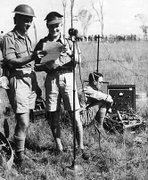
Where did the Weekend go?
Over the course of the so-called long Good Friday weekend, and constantly measuring the beat of the clock representing Time’s unstoppable march to inevitable Monday, one cannot help wondering the boon and curse that this accurate measure of Time entails. One cannot help comparing our fast paced, hectic lives today with the lazier, slower rhythm of the life in the olden days when minutes and seconds were immeasurable and Time consisted solely of the light of day and the dark of night. Maybe our ancestors were better off not chasing the clock. Well, as always, the Historian in me wonder … When did this whole obsession with time start and why was it so important to divide day and night down into hours, minutes and seconds? With a bit of research, I thus attempted to (with Darth Vader’s voice) Trace the History of Time. (Blare of trumpets in the background, please.)
Sun, Sand and Water: Units of Time In The Good Old Days
Sun, Sand and Water: Units of Time In The Good Old Days
The sundial was an early attempt to regulate the day, just in case people had an important meeting to go to but could not differentiate between 1 p.m. and 3 p.m. since it was almost impossible to distinguish these two hours by looking at the sky alone. It must be noted that the 24 hour day was already demarcated by the ancients of Babylonia and other great civilizations but in terms of actually tracking these hours, there were still great limitations to this technology; the first being the obvious need for the sun to be in the sky and the other being the fact that sundials only reflected local time. Thus, if Horse A left Town B at 2 p.m. and Chariot C left Town D at 4 p.m. traveling towards Town E, nobody in their right mind would have any clue what time they would meet, especially if it started to rain halfway. Other than making such Mathematical problem sums unsolvable, sundials were just too inadequate for any serious divisions of time. This was also the case for hourglasses that had sand pouring from one chamber into another. The problem was that if nobody remembered to turn the hourglass over when the sand ran out, they would lose track of time. Water clocks were cool devices that had mechanical gears and other shiny stuff but were so expensive that only emperors and the rich could afford them. Consequently, “before the clock, the central unit of time was the whole day and people drifted through it, accomplishing their tasks to the rhythm of light and dark.”[1]
St Benedictine and the Church: Doing Time In The Monasteries
St Benedictine and the Church: Doing Time In The Monasteries
In the olden days, monks in the monasteries practiced the St Benedictine Rule that required them to pray at specific intervals in the day. As such, there was a need to demarcate these points, leading to the invention of the early clock, which comes from the German word ‘glockke’, or bell, an important feature in the monasteries. Although these clocks employed simple mechanisms, they were relatively more sophisticated than earlier methods of measuring time. Other than the fact that there was now an increased reliance on technology to tell the time, the invention of these ancient clocks also allowed the monks to divide the night into intervals, finally conquering the previous limitations that earlier sundial faced. However, it can also be argued that the clergymen were not representative of society, bearing in mind that the regular schedule of the Benedictine monks did not necessarily reflect the schedules of the everyday townsman or farmer. Thus, despite this breakthrough in the measurement of time, the impact was more felt in the monasteries, rather than the town. What this meant was, monks aside, it remained a long weekend for the rest of us.
The Business Times: Of Public Clocks and Closing Hours
Over the ages, “the cyclical time of the Church was replaced by the linear, valuable time of the merchant.”[2] The needs of the merchants made it advantageous for them to promote time-consciousness among the masses. At the same time, technological improvements were made to the existing clocks, making them more accurate and reliable when compared to the earlier models (if you are old enough to remember this, imagine the difference between the Nokia ‘Banana Phone’ and the Nokia N95). During this period, somewhere in the 14th Century, merchants were keen to divide Time up for a variety of reasons. First, to let people know the opening and closing hours of their businesses; Second, to regulate the working hours of their employees and Third, to synchronize and coordinate the expanding commercial networks and transactions in the different towns and cities. Well, to achieve this, they spent money and installed large clocks in the middle of towns for the people, making Time more accessible to everyone who wanted to know when lunchtime was and what time the ancient equivalent of Takashimaya Shopping Centre would close. From this moment onwards, Time Became Money, setting the stage for the Industrial Revolution.
The Industrial Revolution: The Exploitation Of Time
At the time of the Industrial Revolution in the 18th Century, the humble clock and the accompanying concept of measured time have been taken to be an exploitative feature of the capitalist system. As such, the technological improvements of the clock to this point of time were seen to promote the political agenda of the industrialists. With this in mind, Engels (Karl Marx’s sidekick and the Second Comrade of Communism) exclaimed, “the factory clock as the means and symbol of industrial domination over people and of their exploitation.”[3] Time was measured, dissected and distributed to enhance worker productivity, on a scale much larger than the monasteries had ever attempted. In a way, it was the culmination of the earlier periods of emphasizing prayer intervals. Days became regularized, as society was re-organized with the efficient distribution of Time in mind. For example, bells were rung to signal the end of one interval in the factories so workers could move to another production task assigned to them. Sounds familiar? From that time onwards, more accurate clocks were invented and peoples’ lives became more regularized as societies shifted from rural areas to urban industrialized towns.
Conclusion: Tempus Fugit (Snooty Latin Expression, meaning Time Flies)
It seems we have come a long way from the sundials (that measured Day/Night) to the atomic clocks of today (that measures nanoseconds for reasons unknown). It is a timely reminder (pun unintended) of how technological changes over time (pun unintended again) can explain something as simple as why the school bell ringing is a sign that you have to go to another class and why MacDonald’s is always crowded between 12 p.m. to 2 p.m. It can also explain why in the ‘Good Old Days’ when Time was less regulated in the rural villages, your grandparents could do so many things in one day (insert adventures for example, swimming in the river, climbing trees, constructing homemade pellet launching wooden guns and still sleep at 8 p.m. while you are struggling to finish up your work by 2 a.m. so you can sleep and wake up at 6 a.m. and leave home at 6.45 a.m. to catch the 6.55 a.m. bus and reach school at 7.25 a.m. for assembly at 7.40 a.m. and feverishly copy your classmate’s tutorial answer before class starts at 8 a.m. sharp. Only time will tell (pun unintended, it’s the last one, I promise) whether there will be further divisions when Tomorrow comes. As with most things of Today, the answers can probably be traced to the events of Yesterday.
[1] Jo Ellen Barnett, “Time's Pendulum: The Quest to Capture Time-- From Sundials to Atomic Clocks”, (New York: Plenum Trade, c1998), p.31
[2]Gerhard Dohrn-van Rossum; translated by Thomas Dunlap, “History of The Hour: Clocks and Modern Temporal Orders”, (Chicago: University of Chicago Press, c1996), p.13
[3] Ibid, p.9



3 comments:
in our wired society today, its like a race against time every single day...we rush like mad to finish our tasks because the rest of world is just moving too quickly..at times we wish we had more then 24 hours a day.but sadly we dont..
Very nice illustration of time!
Thats the funny thing. Time as an absolute unit never changed, be it 1000 years ago or even 10 years ago i.e. there will always be 60 minutes in 1 hour but it does seem that the 60 minutes sure passed by more slowly then
Post a Comment